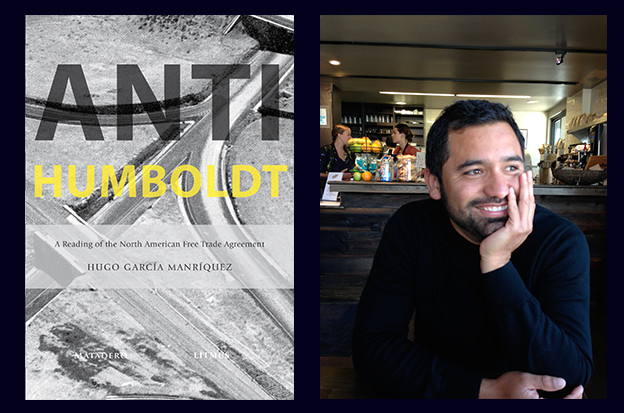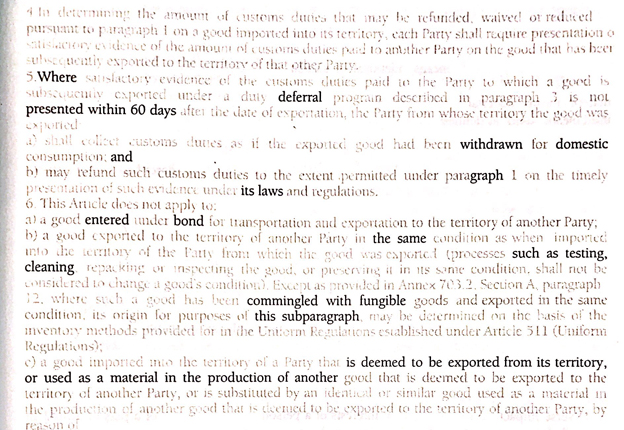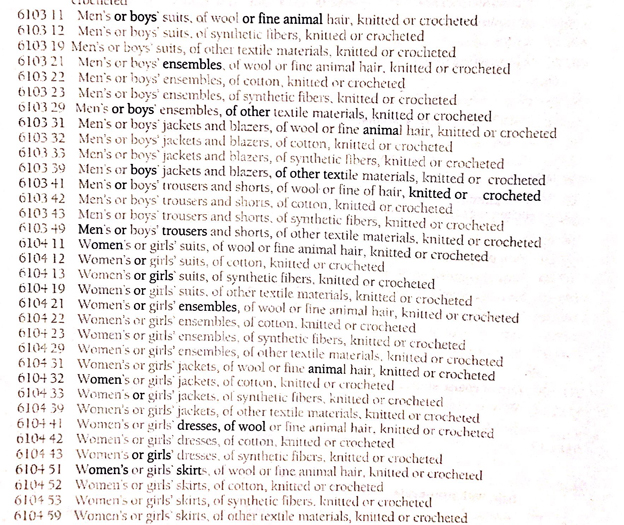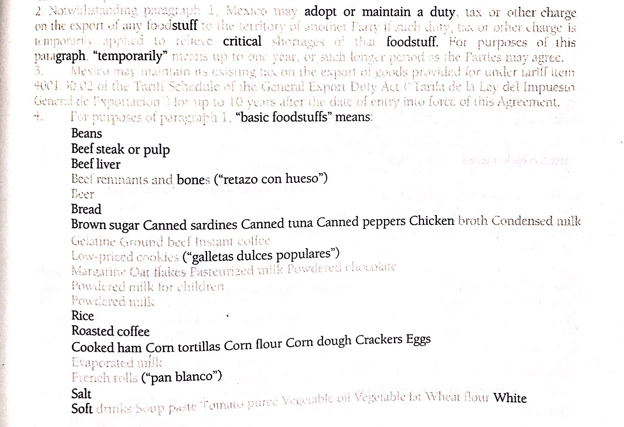From legalese into nothingness
A review of Hugo García Manríquez's 'Anti-Humboldt'

Anti-Humboldt: A Reading of the North American Free Trade Agreement
Anti-Humboldt: A Reading of the North American Free Trade Agreement
As a bilingual and bicultural individual, I have learned that the vectors that constitute my identity pull me sometimes in different directions depending on which side of the border I’m standing. I embody the challenging experience of engaging in conversation and producing works of literature in my second language. This perspective is always present in my writing; the effects of the binational polarization coming from the imminence of the border are unescapable. When it comes to literature that is written precisely at or in tension with the US/Mexico border, how far do the ripples go? One such work of literature addressing the hyper-complex relationship at the border is Hugo García Manríquez’s Anti-Humboldt: A Reading of the North American Free Trade Agreement, published bilingually and binationally in 2014 in Mexico and Brooklyn by a collaboration between Aldus Editorial and Litmus Press.[1] Anti-Humboldt, which takes up the text of the North American Free Trade Agreement, is a bilingual reading and writing exercise involving techniques such as erasure, crossfading, and juxtaposition. The poem is defined by its author as a “bilingual artifact” (71), and as the consequence of “an act of listening inside an act of writing” (73). It is an archaeology of language. It is an exploration and an active evisceration of the document in both its English and Spanish versions. Anti-Humboldt treats NAFTA as a document that spans across the territories of three nation-states, but it does much more than just that. Ghostly forces are now enabling the expansion of the US/Mexico border deep into the entrails of each country, weighing upon the destinies of each of its citizens, sorting out who dies and who doesn’t as an outcome of the borderline interactions between their own sovereignties. Westerners have trained themselves to disregard the effects of deterritorialization. The words of public texts are not being read, even when they are right in front of everyone. But still some words stand out and others fade into the background of the legalese, the magic words of bureaucratic language.
As is often the case with documentary poetry, the focus in Anti-Humboldt is especially set on the kind of reading the text offers as a device or tool. What gesture is provided by the materiality of this language, visible or not depending on the context, and what kind of “poetry within the document” is discovered through the gaze of the poet performing the intervention? This is an epic poem, a proposition to read the legal text from the perspective of the transnational hero as a “citizen of the West.” If we are not meant to read NAFTA like this, then is there a “right” way to read it? Anti-Humboldt provides an answer to this question in the form of a counter-response against the overall imperative of the treaty’s text. While it is still possible to “read” the erasures, the new purpose granted by the poet’s gaze articulates the foundations of the “deferral” of language towards a future use, in a new context or “territory,” used as “material in the production of another.”

What is Anti-Humboldt bringing forth? What is relevant to the poetic voice? What is made relevant by the poetic voice? What should be relevant to the reader? The author speaks of the project in terms of a device tuned up to produce a specific effect on the reader who decides to engage in this relationship:
What poetry can “accomplish” in this project must begin from the re-politicization of language. For me, the difference between politics (pre-established practices and discourses) and the political (the potentially present, though unarticulated) seems crucial.
Instead of writing “like a poet,” I attempted to read like one: creating hollows, pauses, where materials, objects, as well as animal and human life now repopulate the document. (72)
Anti-Humboldt works with the legal text through contemporary traditions such as documentary poetry (for example, M. NourbeSe Philip’s Zong!) and the postal and erasure experimentations enabled by Mexican author and artist Ulises Carrión, and by drawing on some of the same appropriative practices embraced by the conceptual poets. But the piece works in opposition to the apolitical gestures labeled Conceptual Writing as it has been defined by a group of practicing poets from the US and Canada.[2] Anti-Humboldt is part of the Latin American body of literature that is currently being produced inside the US. Far from the postural/gestural apolitical framings of the North American conceptualists, Anti-Humboldt takes a stand against the neoliberal age through one of its most emblematic artifacts. In this sense, it is a poem that belongs to the contemporary writings of the Mexican diaspora, emerging from the long lineage of Chicanx writers. Mexican author and academic Cristina Rivera Garza offers the use of the concepts necrowritings and disappropriation as two qualitative aspects to describe common characteristics shared by some works written in Latin American communities over recent years:
This practice, by taking place in conditions of extreme mortality and in platforms that vary from paper to the digital screen, is what I start to call necrowritings. … The poetics that sustains it without ownership, or challenging the concept and the practice of ownership, but in a mutual interdependence in relation to language, I define as disappropriation. Rather less a diagnosis of current production, and more an effect of the critical reading of what is being produced in the present, these terms pretend to foster a conversation in which writing and politics are equally relevant.[3]
From a perspective based on Achille Mbembe’s theorization[4] of the concept of biopower and sovereignty, one can read through Anti-Humboldt as a kind of writing that confronts the problematic distribution of death and wealth through commerce among transnational instances in the present. This distribution of death and wealth is grounded in the hegemonic entitlement of ownership above the subaltern cultures interacting along and across the US/Mexico border and within each of these territorial entities. Mbembe’s interpretation of sovereignty sees it operating through Manifest Destiny and the Monroe Doctrine, which gave rise to the Mexican-American War (1846–1848) and shaped the way the border still looks in the present day.
Anti-Humboldt recognizes this history of the border as tightly knit together with the history of the development of the United States, as much as it represents a place of trauma for the peoples who were caught in between the new boundaries. For many years, American history has considered the history of the expansion and domination of the Great West,[5] the occupation and profit from what was conveniently considered “free land” and the disregard for the sacredness of ancestral grounds, the brown lives of the ranches and pueblos, and the Mexican American survivors who fought for both sides in the Mexican-American War. The American expansion finds its ultimate expression in the border as a contentious, racially charged boundary, a clear divide between the wildness beyond the frontier and the Anglo “saviors” living within the security of white European civilization.
Anti-Humboldt’s sources can be traced back to several poignant writings by Chicanxs that have addressed the asymmetries gravitating around the border as a painful symbol and heavy burden carried by the Mexican diaspora. The poem mirrors Gloria Anzaldúa’s critique, which was published almost three decades ago but which feels unbearably and painfully fresh within the current context:
Gringos in the US Southwest consider the inhabitants of the borderlands transgressors, aliens — whether they possess documents or not, whether they’re Chicanos, Indians, or Blacks. Do not enter, trespassers will be raped, maimed, strangled, gassed, shot. The only legitimate inhabitants are those in power, the whites and those who align themselves with whites. Tension grips the inhabitants of the borderlands like a virus. Ambivalence and unrest reside there and death is no stranger.[6]
Anzaldúa points to the origins of the border narrative that portrays Mexicans and Mexican Americans as the enemy: the racialization of the enemy, the construction of the Latino threat narrative[7] that has teetered in between policy and discourse in American politics ever since the consolidation of the nation-state, the narrative that justifies the annihilation of brown bodies. The same narrative labels undocumented immigrants as criminals (illegals) for crossing the border without proper documentation, as an invasive people (they took our jobs, taco trucks on every corner) forever under suspicion as a possible threat to domestic security in the post-9/11 age. The anti-Mexican rhetoric that was at the center of the 2016 election has its foundations in the US/Mexico border. The same border was deemed by Anzaldúa “una herida abierta”[8] and assessed as “a place of pain, and a site of violence” by Louis Mendoza.[9]
NAFTA represents the most recent episode in the existence of “the open wound” that keeps bleeding into the lives of the Third World; it is a descendant of the government-sponsored “free zones” established on either side of the border to sustain competitive development of the border cities. The state enables an exception for the sake of commerce, just as it does for the domestication of the West and the colonization of so-called “free lands”; NAFTA enables the expansion of the “free zones.” The repurposing of borders fosters deterritorialization, spreads like a virus, and magnifies the conditions of the “violent, painful” border life at a global hemispheric scale. The virus is now airborne as the outcome of the calculated shift in the definition of the borders. The trilateral treaty is the ultimate expression of decades of racialized violence imposed over the bodies crossing the border. The border patrol, the vigilantes, the cartels, the abrasive conditions of the desert all claiming immigrant lives.
The text of an international free trade agreement has enabled the political and economic powers flowing on either side of the border. It presents itself as an extensive and detailed distinction between which objects fall into the category of legality to cross the border and which don’t. The signing of such an agreement has, consequently, shaped extralegal activities such as drug traffic, smuggling of people and goods, tunneling, permeability, and the emergence of asymmetrical structures.
The initial inquiry opened by the machinery in Anti-Humboldt brings the sovereignty of the borderlands into question. García Manríquez’s perforation and puncture of blocks of texts denounces the deterritorialization as a point of conflict that needs to be “contained” or regulated by an international treaty. The flow within the poem is an act of opening and closing of significance, just as the power of the state is increased or minimized for diverse purposes and at different levels along the border.
A close reading of Anti-Humboldt from this perspective immediately raises questions about the text that makes up NAFTA. Who is it written for? Who are the addressees? What do words like “Mexico,” “United States,” and “Canada” stand for? The writing machinery of Anti-Humboldt demands a clear and strong response from its readership; the poem frames the reader’s gaze, making it possible to locate hidden possibilities in the numerous chunks of language that make up this extensive text. To look for places where its irrefutable force and hemispheric influence take place. The materiality of language points out towards the major absence in the poem: the people.
It’s like some Hollywood rendition of the Holocaust: the viewer can see the clothes, but no bodies are shown; they can be “seen” only through this oblique gesture. The materiality of language sets constraints on the gaze to identify the site of pain, offering a vantage point amidst the endless utterances of products and features. Anti-Humboldt ensures that its readership is constantly asking: who is the hero of this epic poem? Jose Ignacio Padilla frames this question by suggesting that the work is aware that “language is charged with its own history, its politics, its connotations; and it ignores our efforts to ignore it.”[10]

This language is based on the purposefulness and the effectiveness of the border as a legal device to sustain a free market zone, forever changing the lives of the working class and the rural communities of its subscribing entities. Anti-Humboldt unveils the unfairness of policy by focusing on the nature of language when it is used as a barrier to protect the invisible forces of capital operating together with the magical/supernatural powers attributed to law.[11] This method gestures towards Philip’s Zong!: the artifact that writes the poem is taking back the cold dead language of bureaucracy to reembody the story of the lives lost with the sinking of the ship. Zong! disappropriates the language that was used in a trial over a private matter and gives it back to the people who remain, a restitution to the community to be able to mourn their own dead. Anti-Humboldt is also an act of disappropriation working directly with the materiality of NAFTA to embody a writing that becomes a full narrative of the immigrant lives lost because they cannot find a place within the numerous categories in the treaty, the economic refugees who have been disenfranchised by the neoliberal era. It is also a response to the violent categorization imposed by the colonial powers (Prussian explorer Alexander Von Humboldt) who were fully aware of the potential of these lands.

Anti-Humboldt is a quest that embarks, as does Zong!, on an expedition throughout chunks of legalese language that mirror the immanence of the international border. This reading poses a series of questions that open and close access to meaning as the text is emboldened or erased. Spectral figures of what used to be objects. Objects as words and words as objects are framing the experience. Words suddenly arise and stand out from seas of language and then suddenly disappear amidst the functionality of the system established by the original text.
The blank spaces are readily populated by the subjects of this powerful document. The wraithlike presence of a Canadian, a US national, or a Mexican is barely suggested by the term “person” throughout the entirety of the document. That person is the Mexican farmer who, unable to compete with the technology and the prices of subsidized US corn, goes out of business, and is forced to sell ancestral land and migrate north, becoming in the process an economic refugee, risking their life in the desert.
The poetic language in Anti-Humboldt operates at different levels through the legal language of NAFTA, turning it into a rebellious weapon against the global markets and the political contexts that it arises from. Submerging functional language into poetry is a subversive act in this context. The poet is modifying that which shouldn’t be changed. The author has become a heretic of the global era. Depths of meaning burst against the superficial materiality of language in such documents that are currently and ruthlessly ruling the world: after reading Anti-Humboldt one wonders how is it possible that the citizens of the member countries keep a copy of the NAFTA document in every home, just as Divya Victor asks in her article “Miscreants & Miscreative Writing.” The document presides over the destinies of millions across three countries at the turn of the century.
After reading Anti-Humboldt I ask myself once again, what is does it mean to be binational, bicultural, and bilingual? Whose benefit is NAFTA working towards if not for the Mexicans, the US people, the Canadians? While US workers are laid off when factories and assembly lines move south across the border, transnational corporations benefit from low wages and precarious or inexistent health services for Mexican workers. While US workers are laid off, Mexican farmers risk their lives moving north in search of an opportunity, risking everything, losing home and country, and, more often, families, for a small glimpse of survival. NAFTA forced itself as the illusion to Mexicans of entering the super exclusive club, the forbidden realm of First World Economies.
But twenty-two years later, Mexicans struggle more than ever to subsist in depressed economies, under unpayable debt, facing extreme mortality on either side of the US/Mexico border. How is it possible that goods and services can circulate freely in this specific region, while the Mexican bodies that produce them are, if eligible, subject to exhaustive and extensive scrutiny to be able to cross the border? It is not by mere chance that Trump has shockingly referred to Mexicans as “high quality people” on Twitter. His words render Mexican lives as mere labor, and here is where his concept of what a good immigrant is may lie. This becomes especially relevant after reading the treaty articles that are meant to enforce international quality standards.
Anti-Humboldt has informed us about the major absence in the document. What NAFTA is missing in its long and widespread list of goods, services, and products is the enormous amount of bodies that produce such goods, services, and products daily. These bodies have disappeared from the legalese of the document and vanished into nothingness. The results of the 2016 election have proven that there are some lives that matter more than others. While one of the readings of the election postulates that the white working class pronounced itself against neoliberalism, it is impossible to ignore the racial bias at play. It is in this environment of precarity and violence that the US people, and the rest of the world, have become to learn whose dispossession, whose disenfranchisement, matters the most.
NAFTA doesn’t acknowledge the migrant workers, which Anti-Humboldt reveals as ghost texts behind the lines of the actual text of the treaty made law. Ghost subjects bound to the magic powers of words assembled and uttered in the right order to produce the desired effects on a hemispheric level. Ghost subjects populating the US/Mexico border as white crosses bearing the names of the ones who have died at the hands of la migra or other policing forces; those executed by los narcos or the Mexican army; or those who have succumbed to the inclement desert: NAFTA’s martyrs, patron saints of our neoliberal epoch. Those who have found their home on “this thin edge of barbed wire.”[12]
Anti-Humboldt is a work of contemporary writing emerging from “the communities of people who are surviving the abrupt, unwelcome, and often violent process of deterritorialization.”[13] This writing digs up and forcefully clears space for a poetic response against the unilateral, vertical, prescriptive language of the treaty, from the very same materiality of its source. This piece can be considered a textual modality close to some notable contemporary artistic interventions that have engaged, through very similar questions, with the materiality, the geolocation, and the history of the border, such as the collaboration between Marcos Ramírez Erre and David Taylor, and the “erasures” performed by Ana Teresa Fernández along the border wall, or the Transborder Immigrant Tool designed by Electronic Disturbance Theater.
Like these works of art, Anti-Humboldt opens a dialogue. It is part of conversations on the border that point towards renewed opportunities for alliances and collaborations, even within precarious and violent contexts. The work belongs to the kind of art that the Chicano writer, performer, and artist Guillermo Gómez Peña has ruled as essential in envisioning the future of the borderlands and the cultures that interact together through and against the border. Louis Mendoza’s take on Gómez Peña’s words:
Guillermo Gómez Peña defines dialogue as the “opposite of national security, neighborhood watch, racial paranoia, aesthetic protectionism, national sentimentalism, ethnocentrism, and monolinguality.” He suggests that it is only through an ongoing public dialogue in the form of publications, conferences, and collaborative intercultural art and media projects that the wounds caused by borders can begin to be healed. It has been said that “intercultural dialogue unleashes the demons of history.” It is these demons with which we must come to terms through a process in which all parties enjoy equal negotiating powers.[14]
Anti-Humboldt is a piece of innovative writing created by a Mexican author living in the United States. It is a politically charged experimental act denouncing the humanitarian crisis unleashed by the neoliberal era, by summoning the demons haunting free market economies. May this be the writing that speaks for the millions who are now facing deportation, incarceration, or death during the years of Donald Trump’s tenure as president of the United States. The first US president of the twenty-first century who has been publicly endorsed by the Ku Klux Klan, who has proposed a renegotiation of NAFTA over the current four-year term which has already pledged to be one of the darkest periods in the history of humanity.
1. Hugo García Manríquez, Anti-Humboldt: A Reading of the North American Free Trade Agreement(Brooklyn: Litmus Press/Aldus Editorial, 2015).
2. José Ignacio Padilla, “Imantaciones,” Laboratorio de escrituras, literatura y experimentación, 2015.
3. Cristina Rivera Garza, Los muertos indóciles: Necroescrituras y desapropiación (Mexico City: Tusquets Editores México, 2013), 22.
4. See Achille Mbembe, “Necropolitics,” trans. Libby Meintjes, Public Culture 15, no. 1 (Winter 2003): 11–40.
5. Frederick Jackson Turner, “The Frontier in American History,” The Mississippi Valley Historical Review 7, no. 4 (March 1921): 403.
6. Gloria Anzaldúa, Borderlands/La Frontera: The new mestiza (San Francisco: Spinsters/Aunt Lute Books, 1987), 3–4.
7. See Leo R. Chavez, The Latino threat: Constructing immigrants, citizens, and the nation (Stanford: Stanford University Press, 2008).
9. Louis Mendoza, “The Border Between Us: Contact Zone or Battle Zone?” MFS Modern Fiction Studies 40, no. 1 (Spring 1994): 120–21.
11. See Colin Dayan, The law is a white dog: How legal rituals make and unmake persons (Princeton: Princeton University Press, 2011).
12. Anzaldúa, Borderlands, 13.